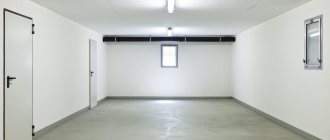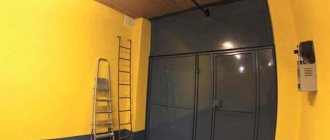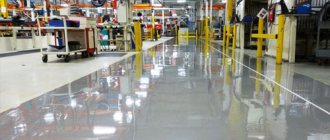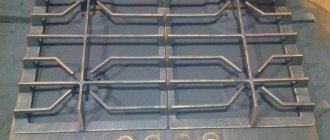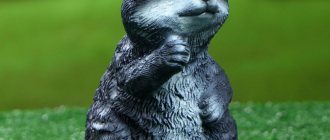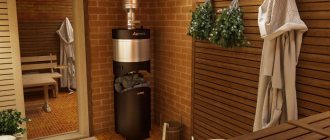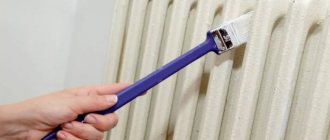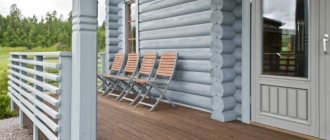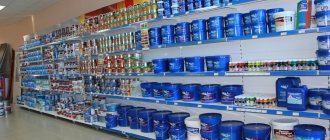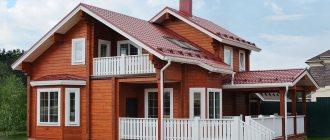After laying a concrete floor, very often the owners of the premises have a question - do they need to paint the floor? The floor definitely needs to be painted. In addition to ensuring an aesthetic issue, you will be able to minimize the risk of injury to the floor, which is out of the operational permit.
What can happen to a floor that is no longer in use:
- Injury due to a fall;
- Violation of the integrity of goods stored in a garage;
- Increasing the frequency of wet cleaning of equipment and machinery located in the garage;
- Ingestion of dust particles from the respiratory tract, and subsequent allergic reaction.
Pros and cons of concrete garage floors
Concrete flooring is by far one of the most common garage flooring options.
Pros:
- Economical option for garage flooring;
- Durable material;
- High strength;
- No tendency to corrosive processes;
- Protecting the premises from parasites;
- Harsh working conditions and high load.
You should also not forget about the disadvantages of concrete pavement.
Minuses:
- A high degree of porosity of the material, which will absorb all odors without additional topping;
- May be very dusty;
- If a concrete floor is laid incorrectly, there is a possibility of rapid manifestation of corrosion processes;
- The appearance of an unpleasant odor.
Experienced builders believe that covering a garage floor with concrete is the right choice, but in order to extend the life of the material, it is necessary to cover the concrete composition with another layer of topping or another material.
Concrete flooring is by far one of the most common garage flooring options.
The need for dust removal, and what to cover with
Additional protection of the concrete floor allows you to increase the strength of the material and significantly reduce the amount of dust generated. To do this, at the stage of garage construction, dry cement or a layer with polymer toppings is laid on top of the fresh mortar. If this procedure was neglected at the initial stage of pouring the floor, the floor is covered with:
- tree;
- ceramic tiles;
- rubber plates or PVC.
You can also polish the concrete or make a self-leveling floor. Each of the proposed options requires relatively high costs. The best way to remove dust from a garage is to apply paint to the floor.
Causes of dust and defects
Either gender will show damage sooner or later. They come in two types: mechanical and operational. Mechanical damage is the most common reason why concrete floors have to be dismantled or renewed.
Mechanical:
- Chips;
- Potholes;
- Blistering of material;
- Cracks;
- Peeling of the top layer of concrete pavement.
Why do mechanical coatings occur? Because during the calculation of the composition-water-sand ratio, errors were made that led to a decreased or increased density of the material. Chips and potholes appear due to active mechanical impact on the area most susceptible to damage. In addition to mechanical damage due to the use of flooring, sooner or later operational damage will appear.
Operational damage:
- Surface dusting;
- Peeling of individual zones;
- Cracking of the screed surface;
- Deformation processes on the screed surface.
Operational damage occurs for the same reason as mechanical damage - an incorrect “water-composition-sand” ratio. The difference is that during operational manifestations the most active impact is not exerted on the deformation zone.
There are also climatic damages that can cause a corrosive process:
- High humidity;
- Sudden temperature changes;
- High temperatures;
- Location in a maritime climate zone.
Chips and potholes appear due to active mechanical impact on the area most susceptible to damage.
Drying floors
After the floor is painted, you need to wait for the floor to dry completely. This stage should take place at a relative humidity of 70-80% and an ambient temperature of 18-20 °C. It is allowed to subject the base to mechanical loads only after 72 hours.
If the drying conditions were not so ideal, then this time may increase slightly - and, conversely, under more favorable conditions, the period may be slightly shortened.
The duration of drying also depends on the conditions that accompanied the process of painting the base. For example, if painting was carried out on fresh concrete, then drying will be significantly longer. If normal conditions have been met, then complete polymerization of the base occurs about a week later, after which the coating acquires the maximum possible mechanical and chemical resistance indicators.
Therefore, it is in your best interest to give the base as much time as possible to dry, this will ensure it lasts as long as possible.
Now everyone knows what can be used to paint a concrete floor, what tools are needed for this, and how much time it takes to give the base maximum performance characteristics. As a result, the top layers of the concrete floor will not turn into dust and absorb moisture.
It is very important to select the right painting materials, try not to save money, and apply priming if it is strongly recommended. Do not buy materials from unverified manufacturers, especially if they are suspiciously cheap
At the same time, it is important to follow all technological steps for painting, to be careful and experienced, and then the concrete floor will be used for as long as possible.
Why paint your garage floors?
The floor in the garage must be painted not only to improve the aesthetics of the coating, but also to increase the level of strength and durability of the concrete coating. Painting a floor does not guarantee 100% durability. Once a year, based on how often the floor is used and for what type of work, it will be time to reapply a coat of paint. It is necessary to choose paint with high resistance to abrasion during operation.
Popular paint compositions for concrete floors:
- Polyurethane;
- Epoxide;
- Acrylic;
- Impregnation;
- Liquid glass;
- Rubber compound.
The floor in the garage must be painted not only to improve the aesthetics of the coating, but also to increase the level of strength and durability of the concrete coating.
Polyurethane paints
Enamel for concrete floor Polymerstone-1
In terms of cost, they belong to the average price category, are distinguished by high performance indicators, and can be one- or two-component. Allowed for use for both interior and exterior work.
- Positive sides. High performance, resistance to various chemical compounds, cost-effectiveness and versatility of use. Can be used for painting various building materials, including wood and metal. This makes it possible to paint not only the floor with water-based paint, but also the doors and garage gates, shelving and inspection pit.
- Flaws. Drying time is at least 24 hours, which creates some inconvenience for users.
Most paints are recommended to be applied over a primer. The primer increases the adhesion coefficient, reduces the consumption of expensive dyes and improves all performance characteristics. The brand of primer is selected depending on the brand of paint; it must be used only according to the instructions.
Polymer paint for concrete
What is required from a concrete screed
Before laying a concrete screed, it is worth considering some factors that may ultimately affect the final concrete surface.
Technical specifications:
- The minimum thickness of the screed depends on the class of composition used;
- It is inadmissible to refuse reinforcement if a high-intensity load on the floor is expected;
- Mandatory waterproofing if there is a possibility of a seasonal increase in humidity.
If the garage area is large, then it is necessary to develop a technological map that will display the location of reinforcement materials and waterproofing joints.
The minimum thickness of the screed depends on the class of the composition used.
Application technology
Before proceeding to the direct application of the dye to the surface of the floors, several preparatory steps need to be carried out. They will be discussed in more detail in the following chapters.
Before proceeding to the direct application of the dye to the surface of the floors, several preparatory steps need to be carried out.
Preparing the concrete surface
The preparation of the concrete base itself will determine how long and well the paint will last. Moreover, the actions differ on concrete structures that have just been built from those that are already standing for a long period of time.
A fresh screed can be painted five days after creation. At this time, the concrete hardens well enough and has the necessary moisture content for applying paint to it.
The surface is leveled, all existing defects are removed from it. Concrete pores are cleaned and cement laitance is removed.
This process can be performed using a trowel or a stiff brush. All dust should be vacuumed up after this.
If painting is carried out on an old concrete surface, then, on the contrary, it must be thoroughly dried. Otherwise the epoxy will start to peel off. The moisture content of the base is determined using a special device. If it is absent, you can glue a film to the surface, after 24 hours they look to see if it is covered with moisture and if it is damp to the touch. If the film is dry, then you can proceed to painting; if not, you should wait until the floors are completely dry.
Next, an inspection is carried out for the presence of flaws. Those places where there are large cracks are expanded to 5 millimeters; such defects will be covered with epoxy putty. The surface is also cleaned and vacuumed.
The surface is leveled, all existing defects are removed from it.
Precautionary measures
Two-component compositions, which are the most popular, must be mixed for painting. At this time, they can release substances harmful to human health. Therefore, work must be carried out in protective clothing, special glasses and rubber gloves are worn, and a respirator is also required.
The room must be provided with good ventilation. Do not use utensils that are used for food purposes. If the mixture gets on the skin, it is immediately cleaned with denatured alcohol or white vinegar; it is not allowed to harden on the skin.
The room must be provided with good ventilation.
Flow calculation
The paint consumption for self-leveling floors is indicated on the packaging and is calculated per 1 square meter. Accordingly, to find out how much material is needed, you need to calculate the area, and also decide how many layers will be applied to the floor.
When calculating the area, all recesses and recesses are taken into account; if the room is complex in structure, then it is divided into several zones, and then their areas are summed up. The average consumption, which is usually equal to 1 mm per 1.5 kg (the exact figure is indicated by the manufacturer on the packaging), is multiplied by the layer thickness and the area of the room.
When calculating the area, all recesses and recesses are taken into account.
Can I use a spray gun?
A spray gun simplifies many types of painting work and saves paint. But in the case of working with epoxy enamel, its use is impractical. After all, enamel is distinguished by its rapid rate of hardening, so it can simply ruin the device itself.
Therefore, it is better to paint with a roller or brush. After painting, you can immediately throw them away; they will become unusable.
It is better to paint with a roller or brush.
Applying paint to the surface
First, a primer mixture is applied to the surface; it serves to improve adhesion to the material. After complete drying, which takes 24 hours. Immediately before painting, the two components of epoxy (hardener and resin) are mixed, the proportions are indicated on the packaging, you must strictly adhere to them. Mix thoroughly, bringing the composition to homogeneity.
The paint should be applied with a roller or brush; the first layer will be rough. Typically, at least two layers are applied, and you can proceed to applying the second after a day.
Before the final layer, chips are scattered, which are standardly included with the epoxy. Polymerization occurs after 24 hours, and final drying takes 7 days.
Typically, at least two layers are applied, and you can proceed to applying the second after a day.
Requirements for a concrete floor
The minimum thickness of the concrete floor screed must be no less than 20 mm and no more than 40 mm. In rooms where there is a possibility of sudden temperature changes and intense loads on the concrete surface, expansion joints are required.
Primary requirements:
- Leveling the surface of the base layer;
- Concealment of passing pipeline routes;
- Ensuring the thermal insulation condition of the room.
If the concrete screed is very old, and not only becomes dusty, but also cracks and even without any special impact, chips appear on it, it is necessary to completely dismantle it. Garage floor painting should only be done on a workable surface.
The minimum thickness of the concrete floor screed must be no less than 20 mm and no more than 40 mm.
Types of materials for finishing floors
The best option for painting garage floors is to do the work yourself, that is, with your own hands. All that remains is to choose the material. Epoxy paints have high adhesion. They are used for applying coatings to old concrete surfaces and new cement-sand screeds. Durable, wear-resistant epoxy film is not subject to destruction in oil, gasoline environments, and is resistant to hydraulic influence.
Water-based concrete floor paint has the ability to withstand frost, heat, and ultraviolet rays, so it is recommended for use in open areas. Painting of concrete can be carried out even on a layer that has not yet dried, which facilitates faster completion of repair work.
Epoxy paint for concrete requires preliminary preparation:
- pigment is added to the base;
- the entire mass is mixed with the hardener;
- the resulting composition is diluted to the required consistency, after which it becomes suitable for application to the surface.
The disadvantage of epoxy paints is rapid polymerization. This quality limits the time during which the coating must be applied. The advantage of epoxy compounds is their relatively low cost. Polyurethane-based polymer paint is durable and elastic. The main advantage of this group of dyes is their decorative properties. Polyurethane composites can be one-component or two-component.
Two-component compositions, like epoxy ones, gain strength after mixing with hardeners. Polymerization of one-component compositions occurs either due to the evaporation of the solvent from the emulsion, or due to reaction with atmospheric moisture. One-component polyurethane composition - enamel. Apply concrete dye with your own hands in a layer not exceeding 1 mm. The reaction starts from the surface, forming an outer film that prevents the polymerization of deeper layers of enamel. Usually the enamel is applied in 2 layers, and the interval between colors should be minimal.
Painting a concrete floor with a two-component composition is carried out after mixing the base with a hardener. The resulting paintwork can be applied in a layer of any thickness: the quality of the coating will not be affected. Disadvantage of the dye: the semi-finished product can only be used at temperatures higher than 5o Celsius. For comparison: one-component paint for a concrete floor in a garage can be used in stable frosts - down to -30°.
Acrylic paints belong to the group of water-dispersion paints; they dissolve in water. Synthetic acrylic resins, which are part of the paints, add brightness to paintwork and provide a variety of palettes. Paints of this type do not burn, do not fade, and can withstand mechanical stress and atmospheric influences. Water-based paints are difficult to use in low temperatures. Another disadvantage is that they cannot be applied to old coatings. Before painting the concrete floor, the working surface is cleaned of dust and dirt. The surface is first primed and then painted. Acrylic compounds have a fast drying time.
Rubber paint is a relatively new product that allows you to paint your concrete garage floor efficiently. They are made on the basis of compositions containing acrylic resins. Rubber paint creates a film on the surface that provides coverage of all decorative layers with which the object was previously painted. This material protects the surface from many influences:
- temperature changes;
- water-salt solutions;
- impacts, friction, fading;
- cracking;
- oxidation, corrosion.
Rubber paint retains its qualities for more than 10 years and can withstand repeated temperature changes in the range from -50 to +60°C. The composition retains the properties of acrylic: the ability to quickly polymerize, brightness, and a variety of colors.
Conditions for painting the garage floor
First of all, the concrete coating must be perfectly dry.
Foundation requirements:
- Concrete composition class – not lower than M 400;
- Getting rid of dust and debris using a construction vacuum cleaner;
- Grouting existing cracks and chips;
- Repeated drying of the surface with a heat gun or construction fan;
- Strict adherence to painting instructions for a specific composition;
- The paint for the concrete floor in the garage must correspond to the intensity of use.
Drying the floor perfectly is a must. Neglecting it risks corrosion and swelling of the composition.
First of all, the concrete coating must be perfectly dry.
Advice from practitioners
No one disputes that the most modern two-component epoxy paints fully meet the requirements of car owners. But the cost of these paints is not affordable for everyone. We will tell you how to have high-quality and stable coating at minimal cost. What is special about the technology? During painting, ordinary sand is used to protect the paint from abrasion and mechanical damage. By the way, such a floor does not slip and is safe to work on. You can prepare the sand yourself, sift it from the river and dry it. This sand is also sold in specialized construction stores. How to paint a garage floor cheaply and efficiently using this technology?
Step 1. Prepare paint, you can use any paint, including the cheapest one.
Preparing the paint
The screed must be cleaned and dried.
Important. You will need an increased amount of paint; the layer thickness is approximately one millimeter. Keep this in mind when purchasing materials.
Step 2. The paint is not applied with a roller, but simply poured onto the floor. Leveling is done with special trowels, then it simply spreads. The work should be done quickly; it takes time to sprinkle the surface with sand, and it can only be sprinkled over a fresh layer.
Step 3 . To carry out the work, you need to have shoes with spikes, they allow you to walk on a fresh layer. As soon as the entire floor is covered with paint, you should immediately begin sprinkling it with sand. It is scattered evenly over the entire area of the garage. The sand will sink into the paint and stick to it.
Paint pouring process
Coating a concrete floor in a garage
Step 4: Leave the surface to dry. The next day, use a broom to sweep away the sand that has not combined with the paint; it can be reused for painting other surfaces.
This method makes it possible to paint a concrete garage floor several times cheaper than using modern dyes.
Paints used for concrete floor
During the construction process, the question often arises: how to paint the concrete floor in the garage? Concrete paint for garage floors should be originally designed for this purpose.
How to paint a concrete floor cheaply? You may not like the answer, but nothing. If you want to save on the quality of the operating surface, then do not paint the floor at all.
Concrete paint for garage floors should be originally designed for this purpose.
Acrylic paint
This is the most versatile product for painting concrete floors in industrial garages. Acrylic paint for concrete in a garage should contain impurities that will increase production characteristics, allowing multi-ton exposure to equipment.
Painting a concrete floor in a garage with acrylic composition – advantages:
- No pungent odor;
- Moisture resistance;
- Larger selection of colors;
- Eco-friendly composition;
- Economical application consumption;
- Short drying time.
The acrylic composition dries very quickly. After 15 hours you can already move freely along it. Technical operation with multi-ton impacts is possible in 2-3 days.
Before deciding how many layers to apply, consider the thickness of the layer and the coverage of the application.
The acrylic composition dries very quickly.
Polyurethane compositions for concrete floors
How to paint a concrete floor in a garage? If you are not interested in the acrylic composition, then pay attention to polyurethane. The consistency of the paint will be thicker than that of acrylic, which means the hiding power will be higher.
The consistency of the paint will be thicker than that of acrylic, which means the hiding power will be higher.
Polyurethane mastics
This type can serve as a method of waterproofing floor coverings. You can choose the color scheme yourself, since polyurethane mastics can also be mixed. Due to the high degree of application density, this composition is able to hide small cracks and chips. Polyurethane composition is one of the most wear-resistant paints for concrete floors.
Drying takes at least 24 hours. You can’t even step on the composition if 24 hours have not passed.
This type can serve as a method of waterproofing floor coverings.
Polyurethane paints
The main difference from mastics is that they are applied in a thin layer. Layer – 1 mm. The paint should be applied to a perfectly cleaned and dried surface. If there are small chips, then it is necessary to carry out work to grout the surface. Drying takes about 24 hours.
The paint should be applied to a perfectly cleaned and dried surface.
Epoxy compounds
How to paint the floor in the garage and the area in front of the garage? Epoxy paint. This composition for painting concrete garage floors is not afraid of ultraviolet rays, high temperatures and high humidity.
The epoxy mixture must be applied in 2 layers. Each individual layer must dry within 24 hours.
But epoxy paint for concrete floors has one drawback - the complexity of the work. If you have not encountered this composition before, then it is better to find specialists who will correctly apply the epoxy composition. The fact is that it hardens very quickly. If you work with the composition very slowly, there is a high probability that unevenness will appear.
This composition for painting concrete garage floors is not afraid of ultraviolet rays, high temperatures and high humidity.
Liquid glass
The basis of the material is a silicate layer. Increases the strength of concrete screed. Not afraid of moisture and mechanical stress. The liquid glass mixture will be very thick, so if it is difficult to work with, dilute it with water. The instructions for the composition will indicate how to dilute the paint.
Increases the strength of concrete screed.
Rubber paint
The rubber compound forms a protective film on the top layer of the coating. Rubber paint for concrete garage floors is non-toxic. Refers to fire-resistant compounds that are not afraid of high temperatures and fires. This composition dries very quickly. An hour after application, you can safely step on it.
Refers to fire-resistant compounds that are not afraid of high temperatures and fires.
What paint is suitable?
When choosing a paint coating for a garage floor, it is recommended to pay attention to materials that prevent negative effects:
- temperature changes;
- chemical substances;
- mechanical impact;
- moisture.
To do this, you should choose durable materials. The best ones in this case are acrylic, polyurethane, epoxy and alkyd paints. A primer is also suitable for garage floors.
Acrylic
If you fill the garage floor with acrylic paint, you can create additional protection against abrasion, chemicals and moisture. This material is considered environmentally friendly, but takes a long time to dry (12 hours). The second disadvantage of acrylic paints is their high price.
Epoxy enamel
Treating the garage floor with epoxy enamel is the best option, since this material is easy to apply and inexpensive. The composition dries quickly. Therefore, epoxy enamel should be applied immediately after stirring.
This composition is also suitable for painting coatings exposed to constant sunlight. Enamel under ultraviolet light does not fade over time.
Polyurethane
Polyurethane is suitable for painting garage floors. This material is highly resistant to the presence of aggressive environments and can withstand prolonged mechanical stress. Polyurethane paint forms a smooth surface on the floor, as a result of which the adhesion of the wheels to the floor covering is weakened.
Rubber
If the garage is used not only for storing the car, but also for various repair work, it is recommended to lay rubber on the floor. The material withstands shock loads and contact with petroleum products. Rubber paint has a long service life exceeding 10 years. In addition, the composition is applied in one layer.
The main disadvantage of rubber paint is its high cost.
Alkyd-urethane enamels
Alkyd-urethane enamels are resistant to abrasion. However, such materials take a long time to dry and do not withstand frequent mechanical stress. Enamels of this type are colored and form a glossy surface on the floor.
Primers for concrete floors
For concrete floors, we recommend using epoxy and polyurethane based primers. They will level the surface layer. Using a primer, you can not only reduce the time of working with the coating, but also save paint, since you do not need to apply an extra sealing layer.
For concrete floors, we recommend using epoxy and polyurethane based primers.
What are the requirements for garage paint?
Let's start our story about how to paint a concrete screed in a motorhome by describing the basic requirements that the finishing layer must meet. After all, it performs not so much a decorative role as it is intended to make the floor resistant to wear and tear and remove dust.
The basic requirements are:
- experienced specialists will tell you that the paint should be durable: a wear-resistant coating will make using the garage more comfortable;
- Wear-resistant paint for a garage must dry quickly, not have a pungent, persistent odor, otherwise staying inside the building for some time can be harmful to human health and uncomfortable;
- fire resistance is an important criterion when choosing, because it determines the level of safety for a person and a car inside the garage;
- chemical resistance when interacting with various types of car care substances accidentally dropped on the floor must also be present;
- In order for the concrete screed to have a neat appearance and be easily cleaned of dirt, the coating must be chosen to be washable: then the painted layer will always look attractive.
There is no universal remedy that will fully meet all the described requirements. It is necessary to select the option with which to paint the cement floor inside the motorhome, taking into account the conditions of use of the building.
How much paint will you need
To calculate the amount of paint we need to know:
- Garage area;
- Condition of garage flooring. The less roughness, chips and cracks, the less paint you will need;
- The number of layers of paint required.
The less roughness, chips and cracks, the less paint you will need.
Concrete varnish family
Protective varnish for stone surfaces
So, we’ve come to the most important and interesting thing – the main criterion for choosing varnishes for a concrete surface. We consider their features and choose the one that is more suitable for your specific situation.
Acrylic and silicone resins as a base for varnish
Example of coating a base with acrylic silicone varnish
Acrylic and silicone resins, which form the basis for the varnish, enable deep surface treatment. Its composition is capable of penetrating into the deep layers of a stone or concrete surface, protecting it from moisture, various chemicals, oils, salts and all kinds of reagents.
Therefore, this type of varnish is often used to cover swimming pools and the floors around them. Acrylic varnish on concrete can create both a matte surface and a “wet stone” effect.
In the price category, acrylic varnish for concrete is the most expensive. But this cost is explained by its lowest consumption among other compounds and short drying time. The best varnish based on foreign-made acrylic and silicone resins, H&C Chatahoochee Sealer, is considered to be the best. But you can also choose equally high-quality analogues from the Element, Wet Stone, Orion and other lines.
Polyurethane varnish
Concrete floor. Coating: colored polyurethane varnish
Polyurethane varnish for concrete today occupies a leading position in its economic niche.
And this is understandable due to its excellent characteristics, such as:
- imparting increased moisture resistance to the concrete surface;
- creating excellent wear-resistant performance;
- not exposed to oil products;
- it is possible to clean with soapy water;
- high decorative qualities;
- availability of application.
To such remarkable performance qualities, it is necessary to add the fact that it is polyurethane varnish for concrete floors and other surfaces that has the lowest cost on the market for similar products.
Attention! It is polyurethane varnish for concrete floors that is recommended for use in garages, shopping centers, industrial premises, schools and other public spaces.
Concrete floor in a supermarket covered with polyurethane varnish
The most popular domestic manufacturer of such compositions is Tistrom - polyurethane varnish of this brand is used precisely where increased demands are placed on wear resistance and resistance to chemicals. Also an excellent varnish for concrete and stone is Petri Concrete and Stone Sealer. It is characterized by a deep action and creates a surface with a “wet stone” effect.
Polymer varnish for concrete coating
Decorative concrete coated with polymer-based varnish
Polymer-based concrete varnishes are also loved by many consumers.
In addition to the advantages of polyurethane varnishes, the polymer component gives concrete additional parameters, namely:
- strength, the polymer composition penetrates up to 10 mm deep into the base, strengthening it;
- protection from moisture and any chemicals;
- possibility of operation in a wide temperature range from −60 to +90 degrees;
- service life up to 30 years;
- quick drying – the coating can be used after 10 hours of exposure.
Texol is the leader in the domestic market among polymer varnishes. This brand is associated with high-quality products that allow you to create a reliable and relatively inexpensive coating on a concrete base.
Epoxy varnish for concrete is a type of polymer composition. Although epoxy is most often used to coat wood and metal products, it also works well on concrete substrates, creating a very durable and attractive shell. When constructing self-leveling floors, epoxy resins are used. The highest quality epoxy varnish is produced under the Nanten brand.
Epoxy resins for concrete floors
In the price category, such polymer varnish compositions occupy approximately the same position as polyurethane varnishes. Although, you can find compositions for 2000 rubles. for 1 kg.
Water based varnish
Water-based varnish applied to a concrete surface
Water-based varnish specifically for concrete is rare. As a rule, such compositions are intended to protect wooden coatings. Less commonly, water-based paint and varnish composition is used for decorative painting of concrete surfaces. The most striking example of such products is PaliStone FP varnish.
This is a water-based polyurethane varnish that does not have a deep effect. It protects only the concrete surface from moisture, giving it an excellent glossy “blush”. The price for such a varnish is considerable, although it is fully justified by the quality of the resulting coating.
Paint application stages
Before starting painting work, read the instructions on the packaging.
Stages of work:
- Pouring a small amount of paint from a paint tray.
- Impregnate the roller with paint and squeeze out the excess so that the layer is even.
- We begin the work process from the farthest corner of the garage.
If the paint dries quickly, we try to work quickly and calmly so as not to encounter any unevenness.
If the paint dries quickly, we try to work quickly and calmly so as not to encounter any unevenness.
Coloring rules
Painting a concrete screed with your own hands is carried out in several stages. Before proceeding directly to applying the paint and varnish material, it is recommended to clean the surface to be treated of debris and dirt.
Due to the fact that concrete has a porous structure, dust accumulates inside the floor, due to which the surface will not be painted well enough. Small particles can be removed using moisture. Shortly before applying paint or enamel, wash the concrete floor and wait until it dries.
It is also recommended to check the humidity level indoors before processing. To do this, just stick a small piece of polyethylene on the floor and wait a day. If condensation occurs, the floor covering should be treated with epoxy paints.
Enamels are allowed to be applied no earlier than 90 days after pouring concrete. The screed must gain strength before processing.
Primer
Impregnation of concrete with a primer is a mandatory step, after which the strength of the screed increases and the pores close. This material increases the degree of adhesion of paints (enamel) and the floor in the garage.
Paint application stages
Before applying paint or enamel, it is recommended to read the instructions on the package. Each composition contains different compounds, as a result of which it imposes its own requirements on the condition of the floor covering. A number of enamels are allowed to be applied to a wet surface, others - exclusively to a dry one.
Staining is carried out during the following stages:
- The paint is poured into the tray.
- The roller is soaked in paint and wrung out. This can ensure uniform application of the composition to the concrete screed. If you do not squeeze it out, protruding stripes will appear on the surface being treated.
- Coloring begins from the far corner. It is recommended to apply the composition in squares, moving along the walls towards the exit from the garage.
When using quick-drying compounds, the entire floor surface must be painted at once. Otherwise the coating will be uneven.
Depending on the manufacturer's requirements, paints and enamels are applied in 1 or 2 layers. In the second case, you should wait until the composition has completely dried, and then begin re-processing the concrete.
The car is allowed to be driven into the garage after 12-24 hours. The time period is also determined by the manufacturer of the paint or enamel.
Temperature
Different compositions have their own requirements for future processing areas. Polyurethane paints are allowed to be applied to concrete at temperatures ranging from 0-17 degrees. The humidity level should not exceed 70%.
Epoxy primers can be used at temperatures from +5 degrees. Acrylic paints should be applied at +18 degrees and above. Rubber has good resistance to environmental influences. Therefore, such compositions can be used at temperatures from -50 to +60 degrees. The main thing in this case is to avoid rapid hardening of the material.
When working with other compositions, you should follow the requirements of the instructions.
Tips for painting a concrete garage floor
Rules and recommendations for coloring are described above. If the paint takes a long time to dry, there may be two reasons:
- High room humidity;
- Broken technology for applying the composition.
A powerful construction fan will help with this.
Painting your garage floor is a must.
Painting your garage floor is a must. Daily mechanical stress can turn a concrete floor into a mountain of dust. The concrete surface will generate dust in any case. The correct technology for laying the concrete screed will only affect how dusty the surface will be.
Polyurethane enamel
This concrete floor enamel can be two-component or one-component (for a garage it is better to give preference to the first type). Such compositions are used for both external and internal decoration.
The advantages of such a paintwork include:
- high stability in extreme temperature conditions (the composition tolerates temperatures from -60 to +80 degrees);
- efficiency;
- mechanical strength;
- wear resistance;
- resistance to chemicals and fuels and lubricants;
- low cost.
Among the disadvantages is the capriciousness of the paint, which can only be applied if the room temperature is not lower than +5 degrees and the humidity is not more than 75%. Otherwise, the composition will not set.
Healthy! There are compositions on sale that can be applied in severe frosts (down to -30 degrees), but their cost will be more than 400 rubles per 1 liter.
Also, the disadvantages of polyurethane compositions include the paintwork taking too long to dry. The first layer of paint takes a day to set, and after covering the floor with the second layer, you will have to wait another 14 days, only after that you can walk on the floor.
The consumption of such floor paint on concrete is up to 0.2 l/m2. Such compositions are used for painting floors in garages, gyms, swimming pools, parking lots and car washes.
Painting self-leveling floor
The flat and smooth surface of the self-leveling floor is ideal for applying paint. For these purposes, special coatings are produced:
- Epoxy paints. The most popular to use. They have the highest degree of adhesion to the base and the greatest strength. The epoxy colored coating is resistant to aggressive chemicals. At the same time, it serves as a waterproofing agent. The color remains fresh for a long time and does not fade. The disadvantage is the need to mix the two components and the impossibility of applying a material of a different chemical composition over epoxy paint.
Multicolored epoxy floor
- Acrylic paints. They differ from other materials in a wide palette of bright and rich colors. These paints are used for artistic decoration, but they are not used for complete floor painting due to their high price. They are odorless and dry in 10 minutes. Acrylic paints are not durable and resistant to aggressive chemicals, so they are coated with a protective layer of polyurethane or epoxy varnish.
- Polyurethane enamels. These paints are two-component and differ from epoxy paints in their increased elasticity.
Car wash floor
Any car service must have a car wash. A car wash bay provides an additional service that is in demand by customers: the ability to not only repair your car, but also wash it after repair is very attractive. In addition, the car wash service is attractive in itself. Car owners take care of the beautiful appearance of their vehicles, and the fines for dirty cars are increasing every year.
Therefore, it is no coincidence that car washes can be found not only as “workshops” of car service centers, but also as independent enterprises. A carefully thought-out car wash plan and its correct implementation allow you to spend reasonable money on creating this business, receive a solid income and avoid unnecessary additional expenses for repairing your enterprise.
Why is a car wash floor so important?
The floor in a car wash is one of the most important components. The better the floor in a car wash is made, the longer it will last and the less you will have to spend on repairing it. It must be remembered that any repair of the floor in a car wash leads to downtime. And this is lost profit.
It is important to carefully consider how and from what materials the car wash floor will be made. The floor in a car wash bay is subjected to serious and varied loads. Since cars constantly drive into the car wash, the floor is subject to abrasion. Particularly serious damage to the floor can be caused by drivers driving into a car wash on studded tires. The floor for a car wash must have high waterproofing properties, because tens and hundreds of liters of water are poured onto it. In addition, the floor must have the highest resistance to oils, petroleum products and detergents - all these aggressive chemicals are inevitable on the floor in a car wash. A separate problem for car wash floors is that a wet floor slips. It is highly advisable to use non-slip coatings; this will protect car wash workers and help prevent work-related injuries.
What materials are best for making a floor in a car wash?
The most popular material used for car wash floors is porcelain stoneware. Porcelain stoneware flooring is quite inexpensive and has a beautiful appearance. In addition, it has good waterproofing properties. But you need to take into account that for ideal waterproofing, porcelain stoneware must be placed on special adhesives and the seams must be treated with special waterproofing compounds, which can make installing such a floor in a car wash much more expensive than you planned. In addition, porcelain stoneware is not sufficiently resistant to impact loads and not all of its types have high wear resistance. To install a floor in a car wash, you will need a particularly durable and 12 mm thick porcelain tile, and it is also desirable that its surface is not smooth. Because porcelain stoneware floors have another big drawback - in conditions of high humidity, such a floor slips.
An excellent solution is a reinforced concrete floor treated with special impregnations, as well as a mosaic floor. Such floors are very durable and highly resistant to aggressive chemical influences. But a concrete or mosaic floor in a car wash has to be built from scratch, at considerable expense.
But what if the future car wash bay already has a concrete base? Is it possible to turn it into a good, long-lasting floor without removing the old concrete and re-concrete the floor in the room? Yes, polymer coatings solve this problem. Polymer self-leveling floors provide excellent waterproofing; epoxy and polyurethane coatings are resistant to abrasion, impact loads, detergents, oils and petroleum products. When using polymer materials together with quartz sand, you can get a non-slip floor in a car wash. A wide selection of colors and decorating the self-leveling floor with colored sand or special multi-colored particles (flocks) give the self-leveling floor a beautiful appearance. Plus, this floor is very easy and simple to clean. The self-leveling floor does not absorb anything and requires minimal cleaning. It will always be beautiful and clean. Polymer self-leveling floor solves the whole range of problems with car wash floors for 10-15 years.
Which type of polymer self-leveling floor is best to use in each specific case? This depends on the quality of the concrete base, on the requirements that the owner of the business places on the floor for a car wash, and also, to a certain extent, on the funds that you intend to spend on installing the floor in the car wash bay. Despite the fact that polymer self-leveling seamless coatings are not among the cheapest solutions when installing industrial floors, our specialists will help you choose a reliable and cost-effective solution.
